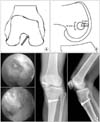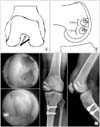Abstract
Purpose
We performed transtibial single and double bundle reconstruction of the posterior cruciate ligament using the allo-achilles tendon and compared the results of single bundle reconstruction and double bundle reconstruction both clinically and radiologically.
Materials and Methods
This study included 41 cases of posterior cruciate ligament reconstruction between February 2000 and June 2007 that had data available for at least 2 years of follow-up. Twenty-two cases (53.7%) underwent single bundle reconstruction and 19 cases (46.3%) underwent double bundle reconstruction. Clinical results were analyzed by Lysholm score and IKDC standards scale, and the radiologic results were analyzed by the Telos® posterior translation test.
Results
The average Lysholm score at last follow-up was 85.4±4.7 in the single bundle group and 87.5±5.1 in the double bundle group. IKDC scores were grade A in 4 (18.2%), grade B in 14 (63.6%) and grade C in 4 (18.2%) in the single bundle group; they were 1 (15.3%), 15 (78.9%) and 3 (15.8%) in the double bundle group. Telos® posterior translation test scores were 5.06 mm (3.04-7.43 mm) in the single bundle group, and 4.04 mm (2.18-7.20 mm) in the double bundle group. There was significant improvement in clinical and radiological scores in both groups (p<0.001). However, these differences were not statistically significant (p>0.05).
Figures and Tables
 | Figure 1Schematic views indicate femoral tunnel of posterior cruciate ligament reconstruction with single bundle technique (A, B). Postoperative radiographs and arthroscopic view show reconstructed posterior cruciate ligament with single bundle technique (C). |
References
1. Bergfeld JA, Graham SM, Parker RD, Valdevit AD, Kambic HE. A biomechanical comparison of posterior cruciate ligament reconstructions using single-and double-bundle tibial inlay techniques. Am J Sports Med. 2005. 33:976–981.
2. Harner CD, Xerogeanes JW, Livesay GA, et al. The human posterior cruciate ligament complex: an interdisciplinary study. Ligament morphology and biomechanical evaluation. Am J Sports Med. 1995. 23:736–745.
3. Race A, Amis AA. PCL reconstruction. In vitro biomechanical comparison of 'isometric' versus single and double-bundled 'anatomic' grafts. J Bone Joint Surg Br. 1998. 80:173–179.
4. Mannor DA, Shearn JT, Grood ES, Noyes FR, Levy MS. Two-bundle posterior cruciate ligament reconstruction. An in vitro analysis of graft placement and tension. Am J Sports Med. 2000. 28:833–845.
5. Stannard JP, Riley RS, Sheils TM, McGwin G Jr, Volgas DA. Anatomic reconstruction of the posterior cruciate ligament after multiligament knee injuries. A combination of the tibialinlay and two-femoral-tunnel techniques. Am J Sports Med. 2003. 31:196–202.

6. Garofalo R, Jolles BM, Moretti B, Siegrist O. Double-bundle transtibial posterior cruciate ligament reconstruction with a tendon-patellar bone-semitendinosus tendon autograft: clinical results with a minimum of 2 years' follow-up. Arthroscopy. 2006. 22:1331.e1–1338.e1.

7. Harner CD, Janaushek MA, Kanamori A, Yagi M, Vogrin TM, Woo SL. Biomechanical analysis of a double-bundle posterior cruciate ligament reconstruction. Am J Sports Med. 2000. 28:144–151.

8. Aglietti P, Buzzi R, Lazzara D. Posterior cruciate ligament reconstruction with the quadriceps tendon in chronic injuries. Knee Surg Sports Traumatol Arthrosc. 2002. 10:266–273.

9. Barrett GR, Savoie FH. Operative management of acute PCL injuries with associated pathology: long-term results. Orthopedics. 1991. 14:687–692.

10. Bergfeld JA, McAllister DR, Parker RD, Valdevit AD, Kambic HE. A biomechanical comparison of posterior cruciate ligament reconstruction techniques. Am J Sports Med. 2001. 29:129–136.

11. Chen CH, Chen WJ, Shih CH. Arthroscopic reconstruction of the posterior cruciate ligament: a comparison of quadriceps tendon autograft and quadruple hamstring tendon graft. Arthroscopy. 2002. 18:603–612.
12. Cooper DE, Stewart D. Posterior cruciate ligament reconstruction using single-bundle patella tendon graft with tibial inlay fixation: 2- to 10-year follow-up. Am J Sports Med. 2004. 32:346–360.
13. Lipscomb AB Jr, Anderson AF, Norwig ED, Hovis WD, Brown DL. Isolated posterior cruciate ligament reconstruction. Long-term results. Am J Sports Med. 1993. 21:490–496.
14. Noyes FR, Barber-Westin SD. Posterior cruciate ligament allograft reconstruction with and without a ligament augmentation device. Arthroscopy. 1994. 10:371–382.

15. Apsingi S, Bull AM, Deehan DJ, Amis AA. Review: femoral tunnel placement for PCL reconstruction in relation to the PCL fibre bundle attachments. Knee Surg Sports Traumatol Arthrosc. 2009. 17:652–659.

16. Petermann J, Gotzen L, Trus P. Posterior cruciate ligament (PCL) reconstruction--an in vitro study of isometry. Part II. Tests using an experimental PCL graft model. Knee Surg Sports Traumatol Arthrosc. 1994. 2:104–106.
17. Burns WC 2nd, Draganich LF, Pyevich M, Reider B. The effect of femoral tunnel position and graft tensioning technique on posterior laxity of the posterior cruciate ligament-reconstructed knee. Am J Sports Med. 1995. 23:424–430.

18. Grood ES, Hefzy MS, Lindenfield TN. Factors affecting the region of most isometric femoral attachments. Part I: The posterior cruciate ligament. Am J Sports Med. 1989. 17:197–207.
19. Saddler SC, Noyes FR, Grood ES, Knochenmuss DR, Hefzy MS. Posterior cruciate ligament anatomy and length-tension behavior of PCL surface fibers. Am J Knee Surg. 1996. 9:194–199.
20. Papannagari R, DeFrate LE, Nha KW, et al. Function of posterior cruciate ligament bundles during in vivo knee flexion. Am J Sports Med. 2007. 35:1507–1512.

21. Houe T, Jørgensen U. Arthroscopic posterior cruciate ligament reconstruction: one- vs. two-tunnel technique. Scand J Med Sci Sports. 2004. 14:107–111.

22. Wang CJ, Weng LH, Hsu CC, Chan YS. Arthroscopic single-versus double-bundle posterior cruciate ligament reconstructions using hamstring autograft. Injury. 2004. 35:1293–1299.




 PDF
PDF ePub
ePub Citation
Citation Print
Print






 XML Download
XML Download